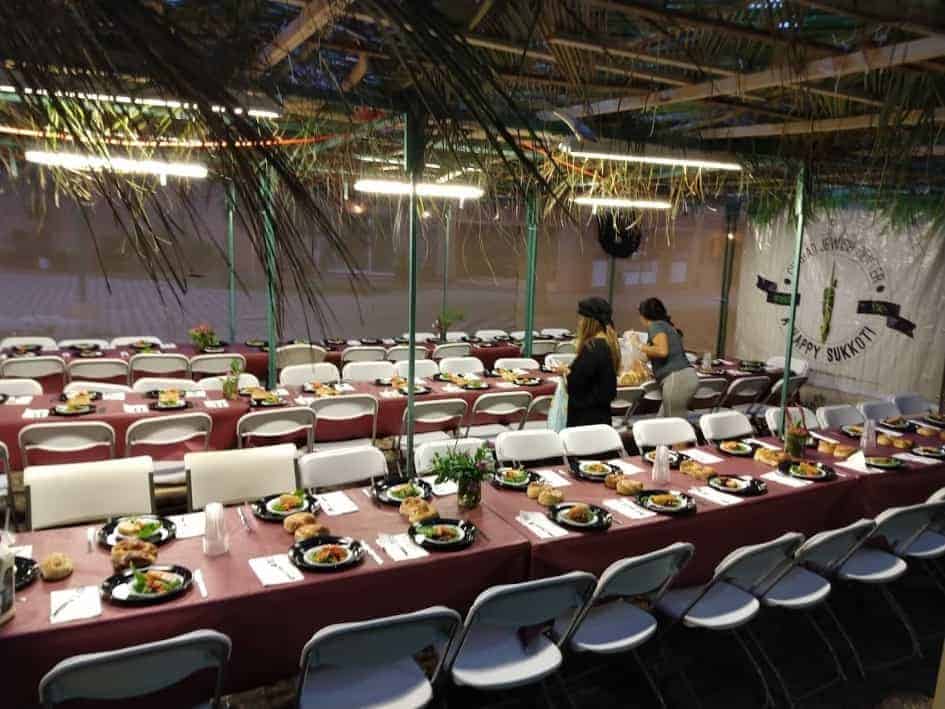Jews In Booths
Five days after the intensity of Yom Kippur, Sukkos, the festival of joy and happiness, begins. This festival lasts eight days in Israel and nine days everywhere else. The Torah describes the festival as follows:
…On the fifteenth day of this seventh month is the Festival of Sukkot, a seven-day period for God: On the first day shall be a sacred holyday when you shall not do any laborious work: On the fifteenth day of the seventh month, when you gather in the harvest of the land, you shall celebrate God’s festival for a seven-day period; the first day is a rest day and the eighth day is a rest day…
This festival is also known in the Torah as Chag HeAsif, the Festival of Gathering, because it is celebrated at the time of year when the harvested produce is brought from the fields into storehouses and homes. When a person gathers in the bounty of his land, he is naturally filled with tremendous joy and happiness. This happiness could easily turn into self-aggrandizement; it could make a person full of himself and his accomplishments, distancing him from God.
We might think that the appropriate antidote would be a period of fasting and repentance, however that would directly contradict the person’s natural inclinations. Judaism does not deny or suppress human nature and instinct, rather it seeks to utilize them in positive ways. The Torah wants us to celebrate and be happy, but to channel that joy toward our relationship with the Creator and with other human beings. We should use this opportunity to appreciate God’s benevolence as well as to share our good fortune with others. As we will discuss shortly, the Torah directs us to use the products of the harvest in the fulfillment of mitzvot. Thus we neither deny the physical world nor wallow in it, rather we elevate it towards a higher purpose.
Gathering in the harvest also takes on a spiritual dimension. The Jewish people have just been through a period of introspection, repentance and prayer: the Hebrew month of repentance, Elul, followed by the Day of Judgment, Rosh Hashanah and the Day of Atonement, Yom Kippur. During this time we labor in the fields of spiritual growth. On Sukkos, we harvest the inspiration, the joy and the closeness to God that is produced by this period of repentance. The intense feeling of joy on Sukkos, is the feeling of one who hears good news (forgiveness) when he was expecting the worst (punishment); of one who has been given a fresh start in life after making many serious mistakes.
In this way, Sukkos reflects the joy of completing a difficult job, celebrating both the conclusion of the physical harvest and more importantly, the culmination of the spiritual harvest. Traditionally, Sukkot is associated with happiness more than any other festival. In our prayers, it is called “the time of our happiness,” while in the Mishnah, it is referred to simply as “the festival.” On Pessach, when we were taken out of Egypt, we were chosen to do a job. On Shavuos, when we were given the Torah, we were told what that task would involve. On Sukkos we, so to speak, come back to God and say “We have accomplished our task; we have brought in the [spiritual] harvest from the fields.”
In ancient times, a celebration took place in Jerusalem’s Holy Temple on Sukkos called the Simchas Beis Hashoevah “the joy of the house of (water-) drawing.” “Water drawing” refers to the water that the Cohanim (“priests”) would pour on the altar during Sukkot service that beseeches God for rain during the upcoming winter. On the evenings of the intermediate days of the festival, people would gather at the Temple. Torches were lit, music played, and the great sages, the elders, would dance and sing, while thousands joyously watched.
The water that gives its name to these festivities refers to rain, but it is primarily understood as a metaphor for the outpouring of Diving inspiration11 that can only be achieved when one is in a state of happiness. The intensity of the joy experienced during this celebration was such that the Mishnah states that, “One who has not seen the joy of the Simchat Beit Hashoevah has not seen joy in his life.”
In the course of Maimonides’ discussion of the laws of Sukkot and of the Simchat Beit Hashoevah, he affirms that, “the happiness that one experiences in performance of a mitzvah and in the love of God Who commanded them is a great duty.” One of the commentaries on Maimonides’ writings explains that joy is a fundamental component in fulfilling all the commandments of the Torah:
The idea is that one should not fulfill the mitzvot because they are obligatory and because he is forced to do them. Rather he must do them and rejoice in performing them, and should do that which is good because it is good. He should choose the truth because it is true. The effort should be trivial in his eyes, and he should understand that it is for this that he was created. When he fulfills the purpose of his creation he will be happy. For happiness due to anything else is dependent on things that are temporary and finite, but the happiness of doing a mitzvah and of learning Torah and wisdom is true happiness.
Today, Sukkos is still a time of tremendous rejoicing. Synagogues and yeshivos around the world, and especially in Israel, celebrate their own “Simchas Beis Hashoevah,” with music, dancing, food and discussions of Torah insights.
The most distinctive feature of this festival, and the mitzvah from which it derives its name, is the Sukkah, the “booth.” The Torah writes,
You shall dwell in booths for a seven-day period; everyone included in Israel shall dwell in booths: So that your future generations will know that I caused the Children of Israel to dwell in booths when I took them from the land of Egypt; I am the Lord your God.
We think of a “booth” today as a place that is quite small and confining. In actuality, a sukkah can be enormous. It is not the size that makes it a sukkah, but the structure’s lack of permanence. The Oral Tradition defines this “booth” as a dwelling place consisting of at least three walls (made of any material) and having a roof made of unprocessed, agricultural products, such as branches and leaves. It is an obligation to live in the Sukkah during the festival of Sukkot. Ideally, one should eat, sleep, relax and socialize in the Sukkah just as one would in his/her home. The significance of this mitzvah, on the simplest level, is to remind us that God protected and preserved the Jewish people in the desert after He took them out of Egypt. By living in the Sukkah, we reenact this experience.
A broader historical perspective offers us a deeper insight into the meaning of this observance. Passover celebrates the Exodus, which was the physical creation of the Jewish people. Shavuot celebrates the giving of the Torah, our spiritual creation. Sukkot celebrates the remarkable physical survival and continuity of the Jewish people, the result of ongoing and all-encompassing Divine Providence.
Considering Sukkot in this light, some Sages of the Talmud explain that the booths represent not the Jews’ physical dwellings in the desert, but rather, God’s “Clouds of Glory” that surrounded and protected the Jewish people from the time of the Exodus until they reached the Land of Israel.
In this light, Sukkos is understood not simply as a reminder of a specific historical period, but rather as an experience that renews our awareness of God’s relationship to the Jewish people throughout history. The desert symbolizes our exile and wandering, while the clouds represent God’s unceasing protection and care.
The central text of the Kabbalah (Jewish mysticism), the Zohar, refers to the Sukkah as “the shade of faith.” Sitting in the shade of the Sukkah, the Jewish people understand that they must not place their faith in the walls and roofs of their houses, or in any physical protection they might construct. We have learned through many years of bitter exile that our efforts only offer protection when they are accompanied by God’s Divine Providence protecting us.
Rabbi Eliyahu, known as the Gaon of Vilna, notes that the Clouds of Glory left the Jewish people when they sinned at Mt. Sinai by worshipping the Golden Calf. The Clouds did not return until after the Jews repented and were forgiven on Yom Kippur. The Clouds of Glory once again encircled the nation on the 15th day of the month of Tishrei, the first day of Sukkos, which is why Sukkos is celebrated right after Yom Kippur — even though it is related to the Exodus and might be expected to occur soon after Passover. Sukkot demonstrates that God’s love for the Jewish people is just as strong after we sin as it was before. The Clouds of Glory were returned to us, even though our own actions had caused them to be removed: the bond between God and the Jewish people is eternal.

